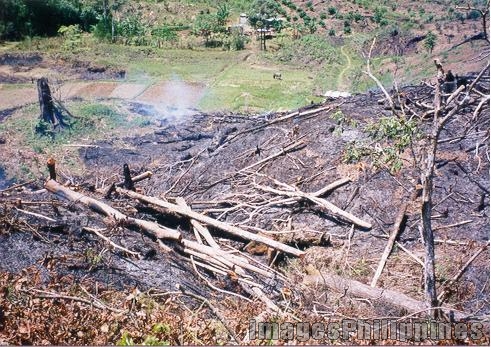 |
| credits to pcij.org |
Considered as one of the richest countries in terms of biodiversity,
Philippines accommodates a wide variety of endemic species, yet most of them
have already been identified as endangered or threatened. The Philippine forests
have been known to be a main habitat for these species. Thus, could one of the
causes for this threat to endemism of species be the rising issue of forest
degradation? More than having endangered species, could the denudation of our
forests truly be one issue that we have to address and act upon to preserve
Philippine biodiversity?
 |
| credits to imagesPhilippines.com/ kaingin/ nueva viscaya |
Our
forests have been threatened over the years, and this is mostly caused by human
activities. One of these major problems in terms of human activities is
deforestation, or the “conversion of forested areas to non-forest land use such
as arable land, urban use, logged area or wasteland”. This results to scarcity
of forest resources and habitat loss for some, if not most, of our Philippine
species. Illegal logging still continues to occur, along with the
kaingin or
slash-and burn system of burning trees, as well as urbanization wherein
population growth induces people to use forest areas for residential and
agricultural purposes. The latter is also a dire issue as the fact that not all
forest lands are fit for agriculture is often overlooked. Moreover, adverse
effects arise upon the occurrence of these problems, such as soil destruction,
landslides, and disastrous floods. Instead of the soil and the forests
themselves becoming the country’s assets, the improper land use causes them to
become liabilities. Thus, forests turn out not to be conducive not just for
human living, but also for other species.
 |
| credits to kalikasan.net/ inadequate reforestation |
Statistics
showed that the Philippine forest cover has declined from 21 million hectares
in 1900 to just approximately 6.5 million hectares by the year of 2007. In a
span of 15 years from 1990 to 2005, Philippines already lost 32.3% of its
forest cover, which is around 3, 412, 000 hectares in total. The prevalence of
this forest denudation leads mankind to find forest management, protection and
conservation harder to attain. With all this human activities that endanger the
forest ecosystem, apathy or indifference may serve as a root cause of these
problems. Yet, to look at what we would be missing if forests were to still be
denuded over time, the forests has lots of potentials that we would make use of
as humans, but not to the extent of abusing and totally destructing the forest
lands. Forest resources could account for wood or lumber supply, raw materials
for furniture and handicrafts, and herbal products. These potentials would not
be possible if total forest destruction were to come about.
It is a good
thing that the government has already done some ways to address this issue. An example
would be the issuance of Executive Order No. 23 by President Benigno Aquino III
last February 2011, declaring a moratorium on the cutting and harvesting of
timber in the national and residual forests and creating the anti-illegal
logging task force. As an example of its policies, it prohibits the Department
of Environment and Natural Resources (DENR) to issue logging contracts and
agreements in all natural and residential forests. This has proved to be
fruitful over time, One report on August 2012 stated a decline in illegal
logging cases, with more illegally cut timbers confiscated more than a year after
the issuance of the said moratorium.
 |
| credits to cepf.net |
In desiring for
forest conservation and sustainability, we must not just ignore these threats
to nature. As Filipino citizens, we can take part in this advocacy to save our
environment. Just by learning to appreciate once again the forests and its
potentials, not supporting the aforementioned forest threats and supporting our
government in their policies towards forest conservation, we could be steps
closer to preserving our Philippine forests and our rich biodiversity.
REFERENCES:
American University (2013). Philippine Deforestation.
Retrieved December 22, 2013, from TED Case Studies:
http://www1.american.edu/TED/philwood.htm
BusinessWorld Publishing Corporation (2012, August 2). Illegal
Logging Cases Decline After Ban. Retrieved December 22, 2013, from Business
World Online:
http://www.bworldonline.com/content.php?section=Nation&title=Illegal-logging-cases-decline-after-ban&id=56185
Butler, R. (1994). Statistics: Philippines. Retrieved
December 22, 2013, from Mongabay:
http://rainforests.mongabay.com/deforestation/archive/Philippines.htm
Conservation International (2013). Philippines.
Retrieved December 21, 2013, from
http://www.conservation.org/where/priority_areas/hotspots/asia-pacific/Philippines/Pages/default.aspx
Philippine Government (2011, February 1). Executive Order
No. 23, s. 2011. Retrieved December 22, 2012, from Official Gazette:
http://www.gov.ph/2011/02/01/executive-order-no-23-4/





No comments:
Post a Comment